Author: Tanay Ved Source: Coin Metrics Translation: Shan Ouba, Jinse Finance
Key Takeaways:
Stablecoin flows have turned positive, with total supply exceeding 160 billion, a record high. This means improved market liquidity and more capital available for deployment in the crypto ecosystem.
The stablecoin landscape continues to expand in terms of diversity, use cases, and risk profiles, from fiat-collateralized and crypto-backed stablecoins to interest-bearing and protocol-native stablecoins.
As stablecoin collateral increasingly consists of USD equivalents and real-world assets (RWA), changes in the interest rate environment may affect the profitability and attractiveness of various stablecoins.
introduce
This article explores the diverse stablecoin landscape, focusing on peg mechanisms, collateral composition methods, and sources of returns in an interest rate environment.
Stablecoin supply reaches new highs
After a period of consolidation in the second quarter, the total stablecoin supply showed a positive growth trend in August, indicating an increase in liquidity and capital inflow potential in the ecosystem. This is reflected in the figure below, which shows the monthly change in stablecoin supply.

Source: Coin Metrics Network Data Pro
As a result, the total supply of stablecoins is approaching $161 billion, again close to all-time highs. With Tether’s market share exceeding 70%, USDT on Ethereum (+28%) and Tron (+26%) has grown over the past year, bringing the total supply to $119 billion across networks including Solana and Avalanche. Meanwhile, Circle’s USDC supply has grown to around $34 billion as it surges across Solana and Ethereum Layer 2s like Base. While DAI trended down to $3.1 billion, sDAI (Savings DAI), a tokenized version of Dai deposited with Maker’s Dai Savings Rate, has grown to $1.34 billion.
Newer stablecoin entrants also gained traction: First Digital USD (FDUSD) on Ethereum grew 56% in August to $3.07 billion, while Ethena’s USDe ($2.96 billion) and sUSDe ($1.16 billion) combined for $4.12 billion. Notably, PayPal’s PYUSD saw rapid growth on Solana, surpassing its $364 million Ethereum supply to reach a total of $1 billion.
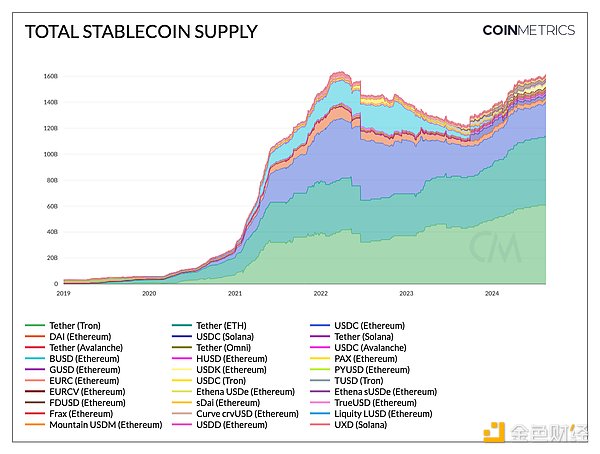
Source: Coin Metrics Network Data Pro
The race for adoption
Diversity of collateral
To improve their utility as a store of value, various asset compositions or collateral methods have emerged in the stablecoin ecosystem, affecting the risk profile, operational characteristics, and regulatory outlook of these products. More than 90% of outstanding stablecoins are collateralized by fiat currencies, such as Circle's USDC, Tether's USDT, and PayPal's PYUSD, which are backed by US dollars and cash equivalents, pegging their stability to the traditional financial system.
Other currencies, such as MakerDAO’s DAI and sDAI, offer alternatives to traditional units of account, backed by a combination of crypto assets and real-world assets (RWAs), such as private credit loans or Treasury bonds. 45% of Dai is backed by crypto assets, while 40% is collateralized by RWAs.
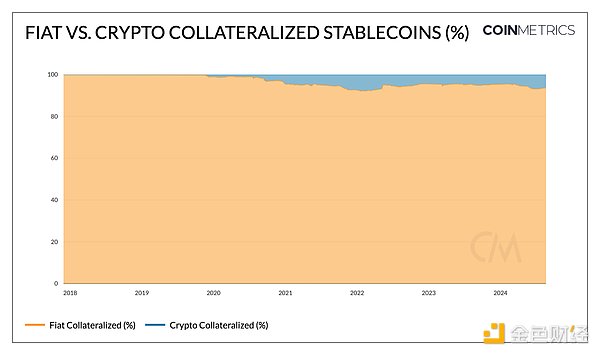
Source: Coin Metrics Network Data Pro
Alternative Accounting Unit
Due to the dollar’s status as a global reserve currency and widespread demand in emerging markets, the supply of stablecoins pegged to the dollar far exceeds that of alternative units of account. However, not all stablecoins are pegged to the dollar. As the European Union makes progress in regulating digital assets through the Markets in Crypto-Assets (MiCA) regulation, the adoption of euro-backed stablecoins has increased. Circle’s EURC, with a current supply of approximately 40 million, is the only euro-pegged stablecoin that complies with MiCA regulations. As more institutions deploy alternative pegged assets, such as Societe Generale’s EURCV wholesale stablecoin, alternative pegs may enable the FX market to expand using on-chain infrastructure.
As different jurisdictions develop their own regulatory frameworks for digital assets, stablecoins pegged to local currencies can facilitate transactions for individuals and businesses within and across regional economies while complying with regulatory requirements.
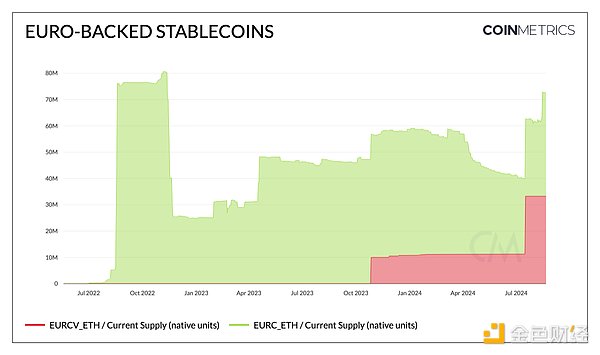
Source: Coin Metrics Network Data Pro
The practicality and scalability of decentralized finance (DeFi)
Stablecoins have found synergy with the business models and functionality of decentralized finance (DeFi) protocols. Following the successful launch of DAI by Maker, many DeFi protocols have launched native stablecoins that fit into their ecosystems. Money market protocols such as Aave (GHO), DEXs such as Curve Finance (crvUSD), and collateralized debt protocols (CDPs) such as Maker & SparkLend (DAI) and Liquity (LUSD) all have native stablecoins with mechanisms to maintain price stability and assist operations within their respective ecosystems.
They facilitate a wide range of financial services such as payments, lending, trading, liquidity provision, and yield strategies. A large portion of the traditional stablecoin supply also exists in Ethereum smart contracts: 27% of USDC, 20% of USDT, and especially over 50% of PYUSD - as stable collateral for lending protocols and decentralized exchange (DEX) quote pairs. In addition, with the surge in tokenized treasuries and real-world assets (RWAs) such as BlackRock's BUIDL and Mountain Protocols USDM, DeFi protocols are beginning to incorporate traditional financial assets into their ecosystems, bridging the gap between DeFi and TradFi.
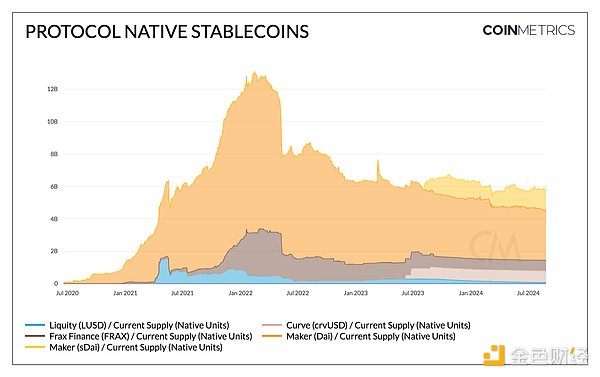
Source: Coin Metrics Network Data Pro
Product Market Fit: Tether on Tron
Tether (USDT) on the Tron network is a prime example of a stablecoin that has established product-market fit. It has shown strong adoption and usage as a medium of exchange and store of value across a range of metrics. Not only does it have the largest supply by far at 118 billion, with ~61 billion on Tron and ~53 billion on Ethereum (plus Solana and Avalanche), but it also has the highest transfer volume and volume relative to other stablecoins. Tether’s (adjusted) transfer volume on Tron is approaching a record $14 billion, with nearly 1 million active addresses.
This usage is driven by Tron’s low transaction fees, supporting micropayments and remittances with low median transfer sizes, and USDT’s deep liquidity on exchanges, facilitating trading activity as a quoted asset. As such, it provides a means to protect savings, seek economic stability, and democratize access to banking infrastructure, supporting peer-to-peer transactions for a variety of purposes — especially in emerging markets.
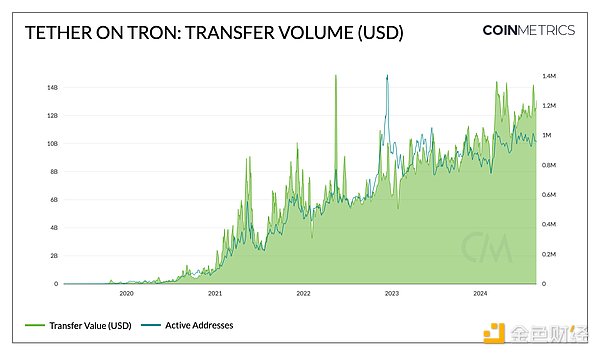
Source: Coin Metrics Network Data Pro
Low fees on networks like Solana and Ethereum Layer 2, combined with distribution from businesses like Coinbase and easier onboarding through smart wallets or point-of-sale systems, provide an opportunity for stablecoins to build a strong foundation on these networks and around the world.
Stablecoins in a changing interest rate environment
Stablecoins are primarily collateralized by the U.S. dollar or equivalents such as cash or treasury bills. Most traditional stablecoins (e.g., USDT, USDC, PYUSD) retain the interest earned on their collateral rather than passing it on to token holders. Tether’s Q2 proof is an example of this, reporting $5.4 billion in profits, in part from direct and indirect holdings of U.S. Treasuries, which reached a new high of $97.6 billion. This puts their exposure to U.S. Treasuries above that of Germany, the United Arab Emirates, and Australia — ranking them 18th among countries holding U.S. debt.
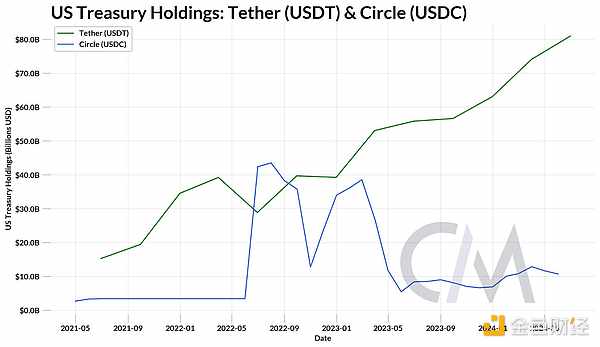
Source: Tether & Circle proof
Where does the income come from?
However, rising federal funds rates and global interest rates after 2021 create opportunity costs for pure USD exposure. This has triggered the emergence of interest-bearing stablecoins that are collateralized by short-term U.S. Treasury bills, money market instruments, and other real-world assets (RWAs) and pass the yield to holders.
For example, Mountain Protocol’s USDM earns its yield from the reserve composition of treasuries, generating interest through a rebasing mechanism. Maker Protocol’s Savings DAI (sDAI) takes another approach, accumulating interest from DAI deposited at the DAI Savings Rate (DSR). This yield is derived from a basket of real-world assets (RWA), crypto assets, and excess reserves backing DAI, implemented through the ERC-4626 vault standard. These products essentially act as crypto savings accounts.
The integration of RWA with public chains also paves the way for institutional-grade products such as BlackRock’s BUIDL, a tokenized money market fund issued by Securitize that uses the USDC redemption fund to provide a 24/7 uninterrupted stablecoin outlet. While tokenized treasury products rely on such off-chain yield sources, others, such as Ethena’s USDe, generate yield through underlying transactions involving delta-neutral hedges (a long position in pledged ETH or other collateral and a corresponding short position in a perpetual futures contract).
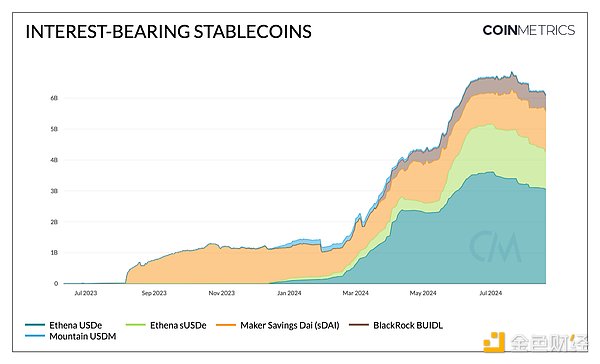
Source: Coin Metrics Network Data Pro
However, Federal Reserve Chairman Jerome Powell's suggestion of a rate cut at the 2024 Jackson Hole Symposium has raised questions about stablecoins in a low-interest rate environment. While fiat-collateralized stablecoin issuers may see reduced profitability due to the interest rate sensitivity of their business models, and yield stablecoins may lose some of their appeal due to diminishing returns, the risk-on environment could bring new capital inflows to the crypto ecosystem. Such inflows, driven by investors seeking to take advantage of lower borrowing costs and higher asset valuations, could offset these effects by increasing demand for stablecoins as a medium of exchange.
in conclusion
The recent growth in stablecoin supply and record highs demonstrates the increasing liquidity and capital availability in the crypto ecosystem. As the landscape continues to evolve, we have witnessed stablecoins being optimized for different use cases and risk profiles, with various collateralization methods from RWA to crypto assets and innovative approaches such as tokenized underlying transactions. Looking ahead, navigating regulatory hurdles and a low interest rate environment presents both opportunities and challenges that could reshape the business model, user preferences, and overall competitive landscape of this emerging industry.






